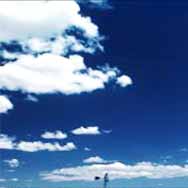Weather forecasting folklore

In the past with no sophisticated national weather forecasting, people learnt to 'read' the signs which predicted particular types of weather. This page explores some of the old sayings and signs which forecasted changing weather.
____
By the webmaster based on observations and discussions with older people
Old sayings which predicted the weather
Some of these old sayings were still spoken of by older people when I was growing up in the 1940s. The most common saying to forecast the weather was:
This saying meant that if the sky at night was red, the weather would stay settled but if it was red in the morning, the weather would be unsettled. It says nothing about temperature, so its helpfulness is limited, but otherwise it has usually seemed fairly accurate to me. The saying clearly arose from the times when shepherds would live out in the fields with their sheep, staying overnight in small huts. Interestingly, the American equivalent replaces 'shepherds' with 'sailors'. I wonder whether this is because the USA and Canada were relatively new countries than Britain where sheep were less important than populating the countries with people arriving by boat from overseas.
Another saying that I remember was:
The oak and the ash were two British trees which were so common that most people would see them in the wild. The saying meant that as the new leaves started to appear on the bare branches in spring, there would be very little rain if the oak leaves came out first, but that there would be a lot of rain if the ash leaves came out first. I never knew how for long this prediction was supposed to last: for the next few days or for the rest of the season, and I never took the trouble to watch and record the leaves to find out. Sadly it is too late now as ash trees are dying due to ash-dieback disease. In fact I am not really sure how accurate the saying was supposed to be anyway. It was said knowingly by older people in the tone of voice that said, 'You mark my words'.
Weather records for the oak and ash
contributed in 2017 by Judith Garforth of The Woodland Trust which keeps records going back to 1736
In 46 of the last 52 years, oak has come out before ash. With every 1°C rise in temperature, oak has a four day advantage. Ash appears to be more responsive to the length of the day. Thus, with warmer springs, oak is able to get ahead.
Signs of the weather to come
A sign which I have often proved to be accurate for forecasting imminent rain was said as:
There is a particular feel for the relatively sudden squalling wind which blows up, accompanied by a darkening sky that heralds the imminent arrival of quite heavy rain.
Additionally some people would say that they could foretell bad weather because their rheumatic pains worsened. This was probably more a matter of sensing an existing increase in dampness and cold before other people noticed. The experience was common in the past when there was no central heating.
Old advice for coping with changeable weather
A piece of advice that I often heard from older people in my childhood was:
In view of the old-style usage of the words 'ne'er' 'cast' and 'clout', the modern translation is 'Never leave off any item of warm clothing until after the end of May'
Of course this advice does depend on where one happens to be located and what the season is like. I am reminded of the advice to gardeners that they should never plant out frost-sensitive plants before June 1st, and I am similarly reminded that my uncle told me that his father always waited until the 1st of June to plant out his tomato plants. Then there was a frost on the night of June 2nd and the lot were lost. So these weather sayings must never to taken as absolute truth.
Old ways of predicting changes in the weather
The saying:
It is well known that when the weather is warm and dry, the air pressure tends to be higher than in periods of bad weather. In the wind and rain, the air pressure is normally lower. The old style barometers which were on walls in many houses indicated the air pressure using a column of mercury which moved slightly up in times of high pressure and dropped slightly as the low pressure approached. Hence the mercury 'falling' was an indication of bad weather on the way.
Cloud formations and wind directions associated with changing weather
I am sure that there were numerous well-known ways of predicting the weather in the past when people couldn't access sophisticated weather forecasts as we can today. Probably people would have learnt the meanings of cloud formations and wind strength and direction for forecasting the weather. However, the above are the only common sayings that I used to hear. My parents and my grandparents would probably have heard more. I did have a look for more on the internet and there were quite a number of weather sayings there, but I never heard any of them said so can't vouch for them.
| sources | webmaster | contact |
Text and images are copyright
If you can add anything to this page or provide a photo, please contact me.



